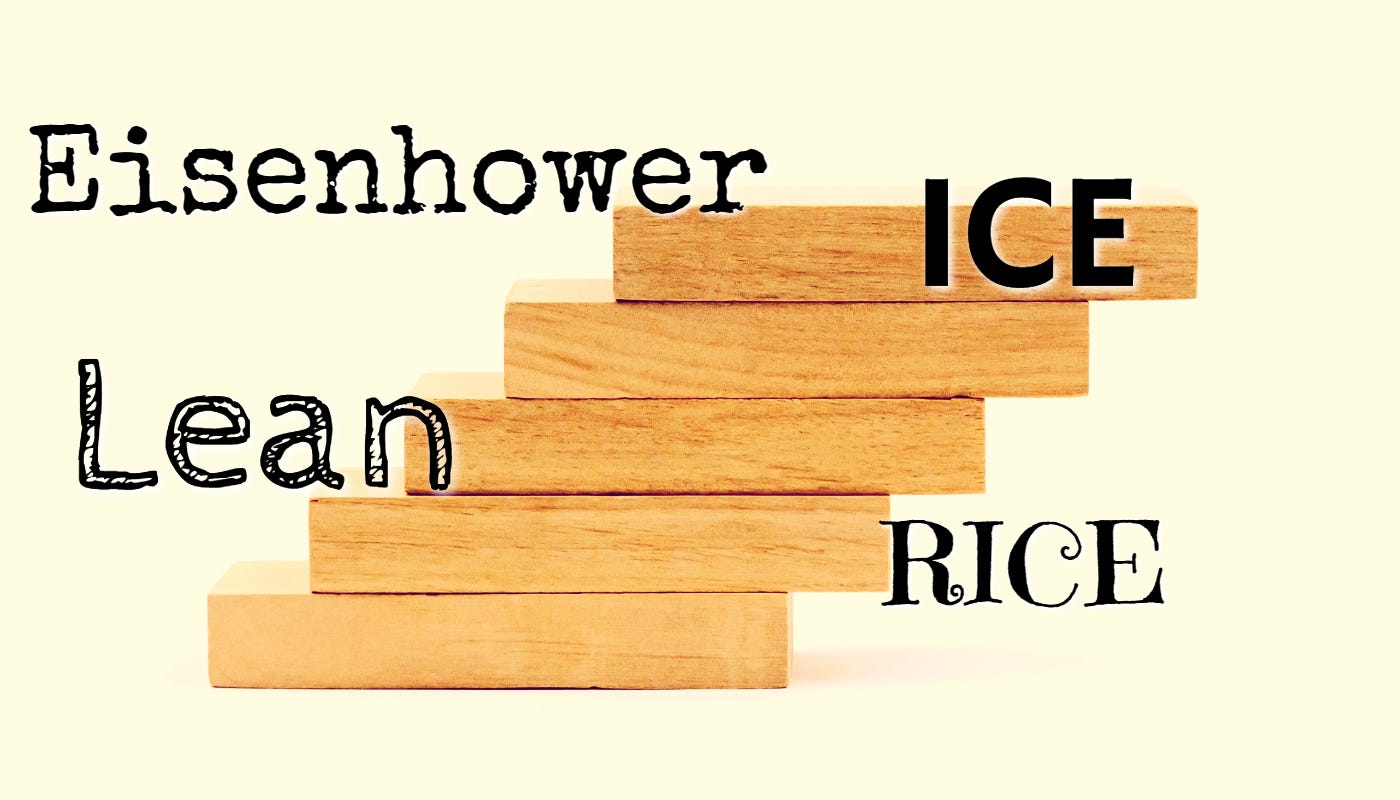
Prioritization is the curious art of choosing what to do and where to focus. The question I keep asking myself is, “Is prioritization the most important thing that we do?”
So before we dive into ways to prioritize let’s ask why picking a way to prioritize should be the number one thing on our list of priorities.
In 1896, Vilfredo Pareto observed a surprising relationship between outcomes and causes. Namely that 80% of outcomes came from only 20% of causes.
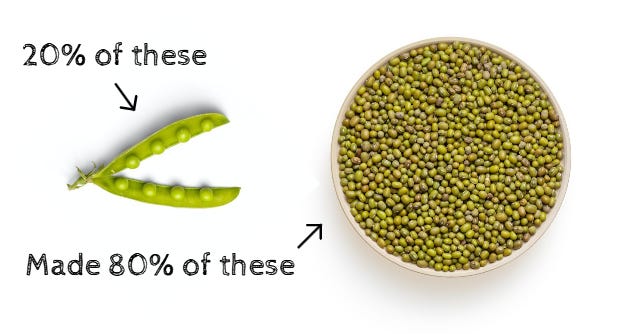
Pareto noted this phenomenon in land ownership distributions of different countries. He later noted it in nature, specifically, his own garden where he was determined that just 20% of his pea pods produced 80% of his peas.
Since then Pareto’s observation has been shown to apply in so many different circumstances that it is now commonly referred to as the 80/20 rule.
In business, it gets applied as a rule of thumb to every use case you can think of. Note that the relationship does not need to be exactly 80/20. It might be 90/10 or 70/30 but the principle of uneven impact is the key insight.
When it comes to our to-do list, Pareto’s rule promises a productivity leap in multiples of 3x/5x may be in reach by focusing on the types of tasks that are likely to pay off and eliminating the waste of those that aren’t.
So, you might be asking what hard data there is in business to support this view. The results are sobering. In one 2009 study Microsoft found that only 1 in 3 ideas that were delivered had any positive impact at all when measured against success criteria.
The remaining 2 in 3 ideas had no significant impact or worse yet, a negative impact on desired outcomes. From the same study Netflix is said to,
“consider 90% of what they try to be wrong.”
Management consultancy Qualpro ran a testing experiment which tracked 150,000 business improvement ideas over 22 years. It reported that,
“75% of them either had no impact on performance or actually hurt performance.”
Cognitive bias is another branch of research that can guide us by helping us to understand how our biases effect our choices.
- The Projection Bias is our tendency to take on high effort tasks when we feel motivated and to assume — wrongly — that we will maintain the same level of motivation and performance throughout.
- The Optimism Bias is our tendency to overestimate the impact of our projects and to underestimate how long they will take to deliver.
- The Urgency Bias is our tendency to focus on low pay-off tasks that have urgent timelines over high pay-off tasks that don’t have urgent timelines.
Pulling your hair out can sound like a tempting way to pass the time after reading research like this — but what can we do with it to prioritize better?
Here are four ways to prioritize work that help keep our biases in check and keep us focused on what matters.
Named after the 34th president of the United States. Eisenhower’s insight was that we focus simply on the urgent, often at the expense of the important.
Or in other words that we fall into the trap of prioritizing short-term outcomes over long-term outcomes.
“Who can define for us with accuracy the difference between the long and short term! Especially when our affairs seem to be in crisis, we are almost compelled to give our first attention to the urgent present rather than to the important future.”
~ Dwight D. Eisenhower
It looks like this
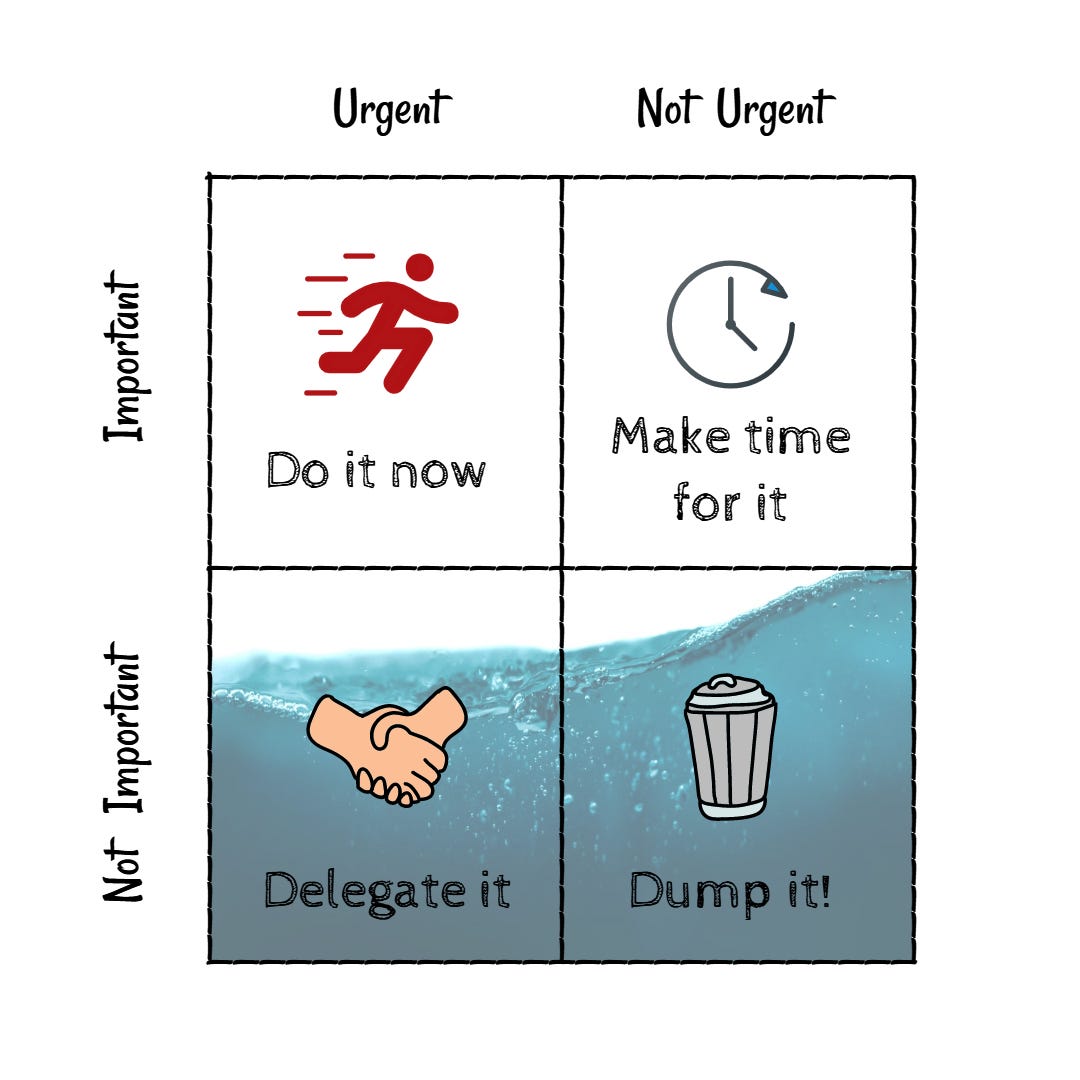
This simple matrix has two critical dimensions: importance and time pressure. “Urgent” means that there is a clear consequence of not doing something in the short term while “Not urgent” reflects the long-term implications. It counteracts our Urgency Bias by prompting us to think about what matters.
To get started simply label your ideas or tasks with “Important” and/or “Urgent.”
Have an “Important” label and an “Urgent” label, think about them, use them, and talk about them with your teams. The key thing is to put real thought behind how the labels are used and to be as consistent as possible within a business layer.
One point we haven’t covered yet is that there are different types of things that can be prioritized including problems, solutions, goals, ideas and tasks.
Any or all of these can go into an Eisenhower matrix. It’s a powerful and general prioritization tool that can be used at every layer within a business.
If used at the higher levels of a business to prioritize goals then you’ll want to think about how to measure value and effort needed next.
The Lean Method of Prioritization spread to other industries from Lean Manufacturing. Lean Manufacturing is rooted in Toyota’s renowned method of efficiency named The Toyota Way. And The Toyota Way’s chief architect was Shigeo Shingo.
“The most dangerous kind of waste is the waste we do not recognize” ~ Shigeo Shingo
Lean Prioritization hones in on those two simple factors: value and effort. It gets to the crux of productivity. The essential idea is to focus on low effort & high value activities first whilst avoiding those that are high effort & low value.
With clear goals in place the idea at this point is to get bang for your buck. It looks like this
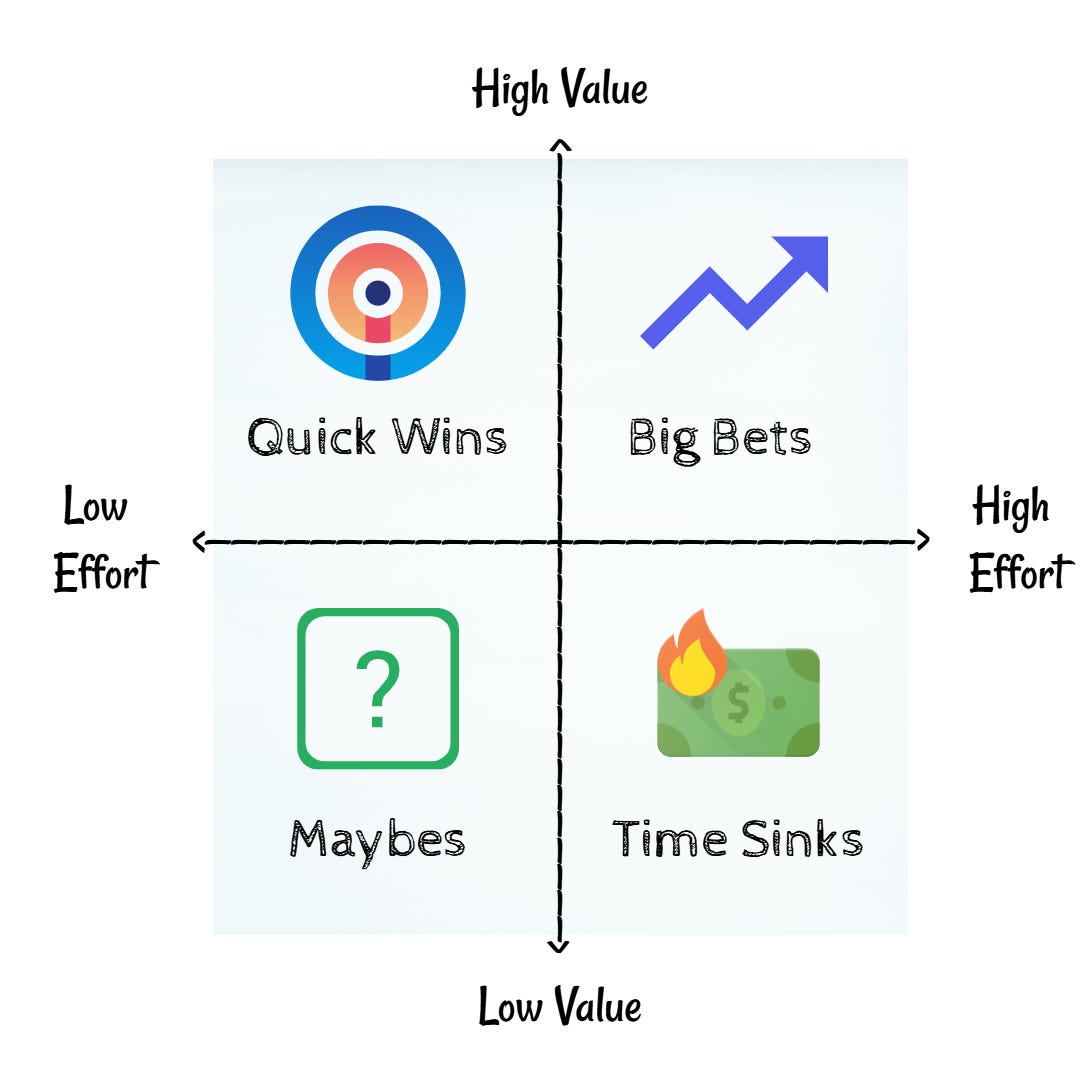
Lean Prioritization hones in on high impact work seeking the 3x-5x productivity gains promised by the 80/20 rule.
It is a powerful method but can it be improved? Yes, by accounting for our Optimism Bias.
We can improve on this model by adding a variable that prompts ourselves to consider how sure we are of our assessments: Confidence.
“There is no question that stalled growth is one of the most pernicious and pressing problems for today’s businesses, and that’s not just true for start-ups, but for just about any business, large or small, in just about any industry you can think of.” ~ Sean Ellis
Sean Ellis coined the term Growth Hacking. He was renowned for it at Dropbox where customer growth challenges were solved incredibly well. To deliver those results a way of prioritizing was essential and it was during his time at Dropbox that he invented the ICE scoring method for prioritization.
ICE: Impact, Confidence, Ease.
A good way to think about the variables is
- Impact should reflect the impact on a key outcome we want to achieve.
- Confidence is how sure we are that we will have this impact (i.e., what evidence do we have)?
- Ease reflects the effort needed, usually by factoring in person weeks.
It is easy to get started with ICE as Impact, Confidence and Ease are all simply scored out of 10 and multiplied together to give the prioritization score.
It looks like this

The addition of Confidence also reminds us of another very important point. As an initiative runs Confidence should increase.
This is because as new information is gained our initial assumptions of Impact should be put to the test and should be getting verified.
If done correctly then we become more sure of the impact (and incidentally ease/effort) as we deliver.
So each initiative should also be periodically reassessed in the priority stack with that new information.
That means progressing initiatives to intentionally improve Confidence as fast as possible is important.
If it’s not going to work then fail fast — pivot or scrap it. The productivity gains are worth it. And by reassessing priority we also counteract our initial Projection Bias.
From here it is possible to tailor ICE to a narrower scope for a specialist team.
The RICE method is a popular prioritization method for product management that is a modification of ICE. Sean Mcbride invented it for the specific case of prioritizing a digital product roadmap at Intercom.
So why is prioritizing a product roadmap so difficult? Let me count the ways:
1/ It’s satisfying to work on pet ideas you’d use yourself, instead of projects with broad reach.
2/ It’s tempting to focus on clever ideas, instead of projects that directly impact your goals.
3/ It’s exciting to dive into new ideas, instead of projects that you’re already confident about.
4/ It’s easy to discount the additional effort that one project will require over another.
~ Sean Mcbride
RICE is a degree more specific than ICE. R is Reach as in how many customers a feature change might reach in a project. I is Impact, C is Confidence, and E flips from Ease to Effort and becomes the denominator in this equation.
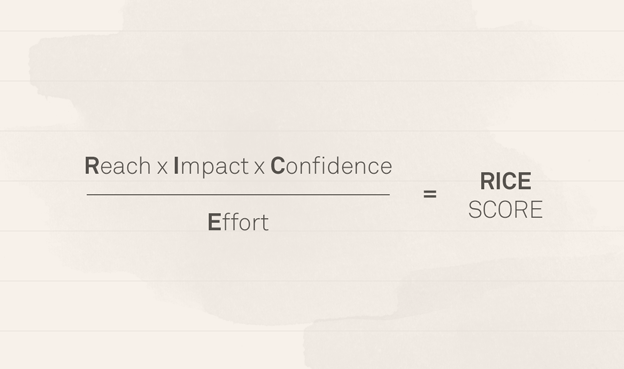
The scoring of each variable in RICE is also more specific than ICE.
- Reach is how many people will be impacted in a defined time period.
- Impact is how much each person will be impacted: Massive = 3x, High = 2x, Medium = 1x, Low = 0.5x, Minimal = 0.25x.
- Confidence is your level of confidence in your assessment: High = 100%, Medium = 80%, Low = 50%.
- Effort is in the expected number of person-months to deliver the idea.
When implemented it looks like this
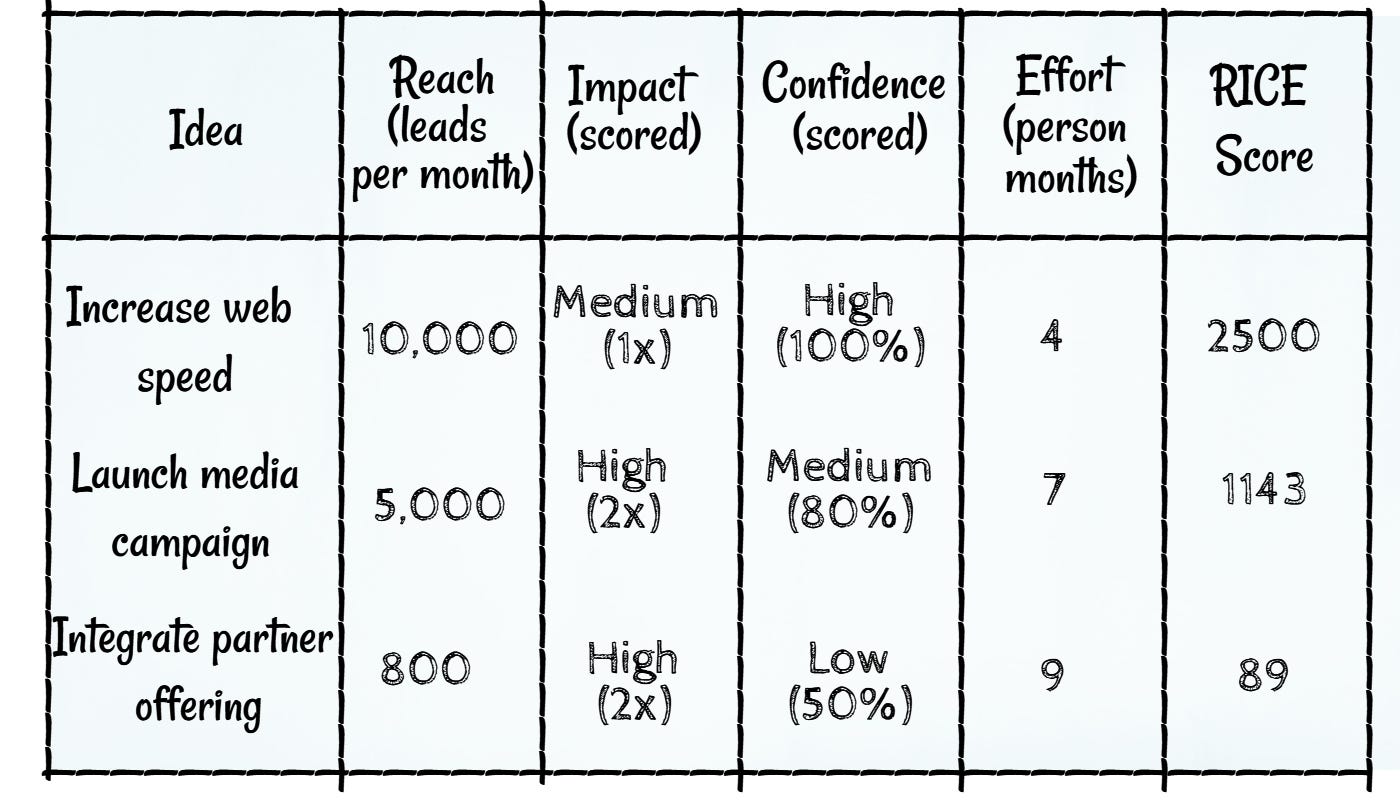
Of course, Reach is not an applicable variable for all teams. It works for a product team prioritizing lead conversion but an Information Security team, for example, would be hard pressed to make it relevant.
The idea here is to show that when all of the tasks being prioritized are of the same type then ICE prioritization can be adapted and further evolved to fit a specific context like in RICE.
It also follows that a generalist team responsible for many different types of tasks will likely have a greater challenge prioritizing them than a specialist team with a clear focus on a narrower set of task types.
Prioritization sets the course for the actions we take. For business it can mean the difference between success and falling behind the pack.
With the stark 65–75% failure rates when it comes to achieving successful outcomes on business ideas (including in some of the world’s top companies) we must ask ourselves whether we can do better.
And the potential productivity gains are significant. We can benefit from methods of prioritization that counter our human biases and get us focused on the best ideas that have the greatest impact.
Although any of the methods we covered can be used individually, you can also get started with prioritization by combining them together like so:
- Simply label team ideas and tasks as Important/Urgent (Eisenhower)
That also means clarifying team goals and considering which tasks roll up into which goals. An important task may support one goal or many goals. Focus mainly on the important. - Now think about value and effort needed next (Lean)
Think of solutions towards reaching your goals and focus on high value and low effort first. - Now think about confidence (ICE)
What evidence do you have to support your estimate? Can you deliver in a way that your confidence increases as you work? That way you can focus on winning ideas quicker and drop losing ideas faster. - Are you a specialist team that can use a tailored approach? (RICE)
Think about how many different types of tasks you are prioritizing and whether you can consider a tailored approach in your team (like RICE).
Other key factors to agree:
- Who is responsible for prioritization? Typically this might be the team lead or product manager.
- Where is prioritization tracked? It’s easy to start with a simple list and over time move it to a workflow solution.
- How often does re-prioritization occur? Increased confidence in expected impact should drive re-prioritization.